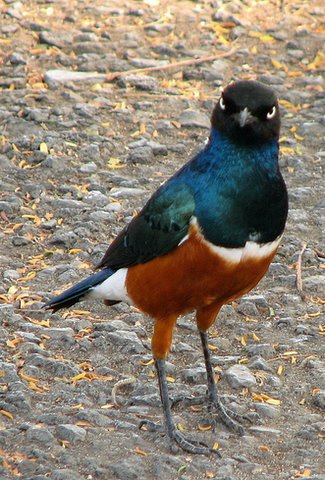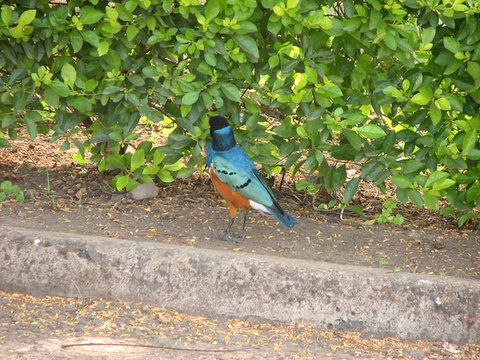Birds in Kilimanjaro Airport....
On the 23rd morning, we landed at Kilimanjaro (no, we couldn’t see the peak from the flight because of heavy clouds) and realized that the flight on which the rest of the family (who had just finished visiting the Pyramids in Egypt) would not come in until 2 pm. So we spent our time clicking happily…some of the common birds in the area were known to us, and others proved delectably new, and our guide, Huruma, was much amused!
Let’s start with one of the most common birds in Tanzania…
That’s the Superb Starling, and though we didn’t get tired of it by the end of our visit, as Huruma predicted, we certainly saw these birds in their thousands, all over the place! But that didn’t detract one bit from their fantastically colourful, iridiscent plumage…. it shone like a satin neck-of-the-peacock…
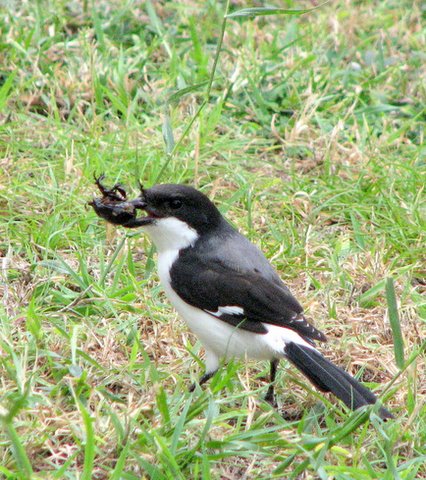 I've got a nice video of the HELMETED SHRIKE having that breakfast, will post it to YouTube later!
There there were the SWALLOWS, which had built a nest under the overhang of the airport building. Here's the mother in the nest:
I've got a nice video of the HELMETED SHRIKE having that breakfast, will post it to YouTube later!
There there were the SWALLOWS, which had built a nest under the overhang of the airport building. Here's the mother in the nest:
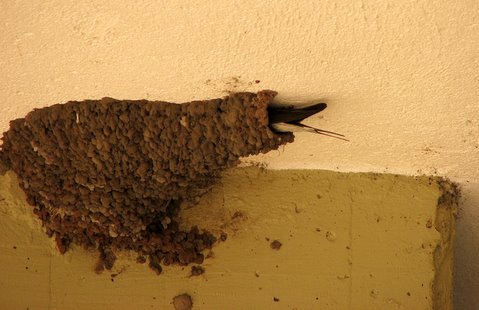 And here she is, swooping out in a fraction of a second; how I wish I had
And here she is, swooping out in a fraction of a second; how I wish I had 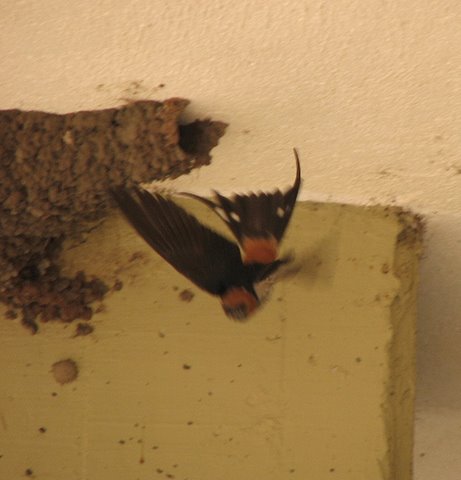 And here's the baby bird asking the mother to feed it, on the wire near the nest!
And here's the baby bird asking the mother to feed it, on the wire near the nest!
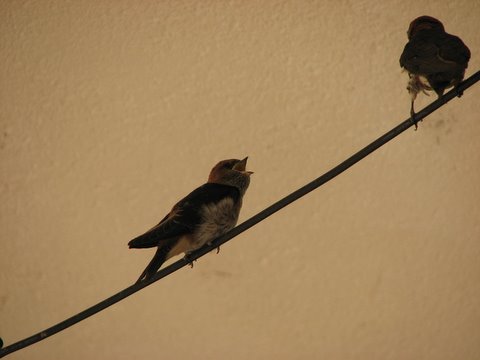 I do love looking at mothers and babies, and as if to indulge me, I do see so many of the mother-and-child combinations. I could not get a good picture of this mother PURPLE-RUMPED SUNBIRD feeding her baby,but I know you will still like to see it:
I do love looking at mothers and babies, and as if to indulge me, I do see so many of the mother-and-child combinations. I could not get a good picture of this mother PURPLE-RUMPED SUNBIRD feeding her baby,but I know you will still like to see it:
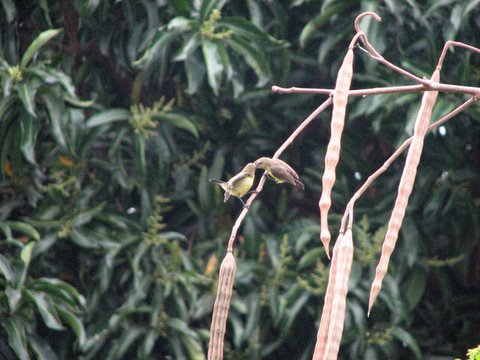 The tree on which they are sitting is so common here, too, the tree, called in Tamizh, "murungakkai" or "drumstick tree", which is a small tree; I never got to find out if the vegetable (and the leaves, too) that we use so much in our south Indian cuisine, is used in Tanzanian cuisine...and the leaves in the background are, guess what, the mango tree, Mangifera indica!
Here's the RED-EYED DOVE:
The tree on which they are sitting is so common here, too, the tree, called in Tamizh, "murungakkai" or "drumstick tree", which is a small tree; I never got to find out if the vegetable (and the leaves, too) that we use so much in our south Indian cuisine, is used in Tanzanian cuisine...and the leaves in the background are, guess what, the mango tree, Mangifera indica!
Here's the RED-EYED DOVE:
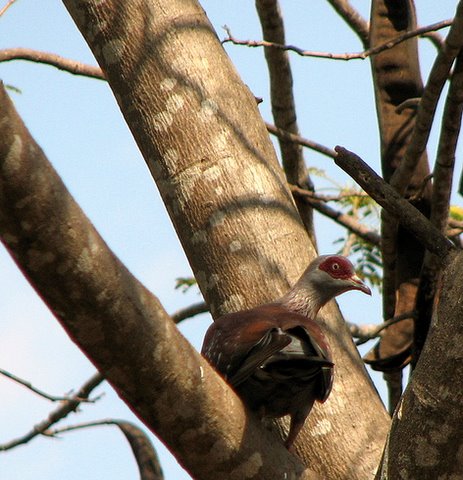 Here are some AFRICAN SILVERBILLS at the tap in the garden:
Here are some AFRICAN SILVERBILLS at the tap in the garden:
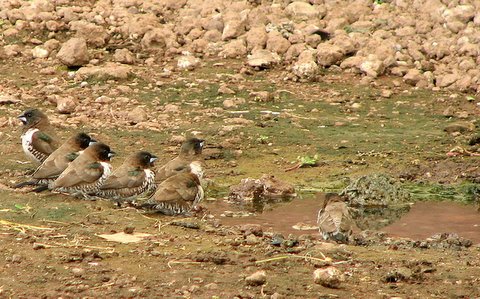 And, at the same tap, this RED-BILLED FIREFINCH arrived a litle later:
And, at the same tap, this RED-BILLED FIREFINCH arrived a litle later:
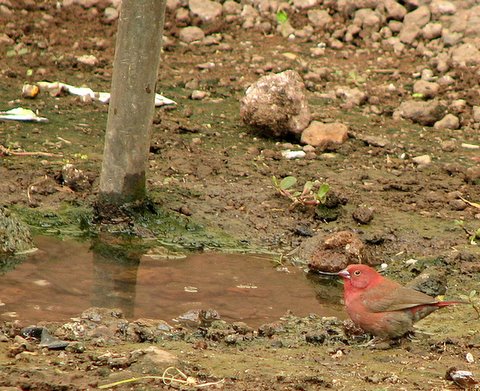 Then we come to the PIED CROWS of Kilimanjaro....amazing to see what look like ravens wearing white vests!
Then we come to the PIED CROWS of Kilimanjaro....amazing to see what look like ravens wearing white vests!
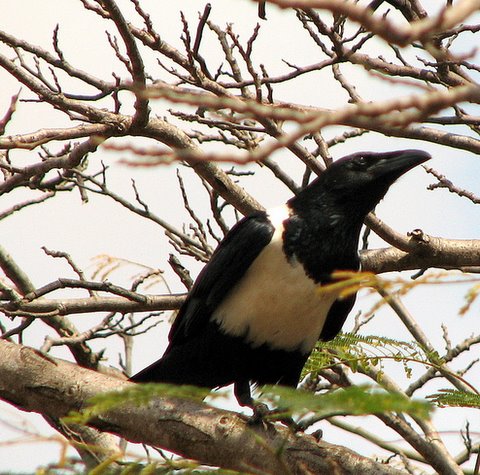 There are also the WHITE-NAPED CROWS, which just have a white patch on the nape of their necks. Here's a photo of some pied crows bathing in a pool of water:
There are also the WHITE-NAPED CROWS, which just have a white patch on the nape of their necks. Here's a photo of some pied crows bathing in a pool of water:
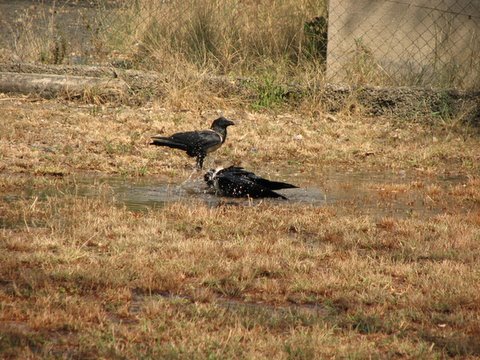 Then there were the SOCIABLE WEAVER BIRDS, which flock round in large groups; I loved this pyramid of the weavers:
Then there were the SOCIABLE WEAVER BIRDS, which flock round in large groups; I loved this pyramid of the weavers:
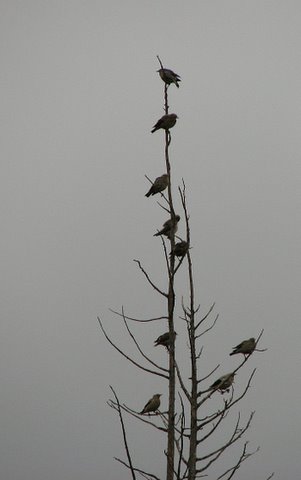 Another familiar face (well, beak and feathers as well!) was the drongo, but of course, here it was the AFRICAN DRONGO, not the Indian one!
Another familiar face (well, beak and feathers as well!) was the drongo, but of course, here it was the AFRICAN DRONGO, not the Indian one!
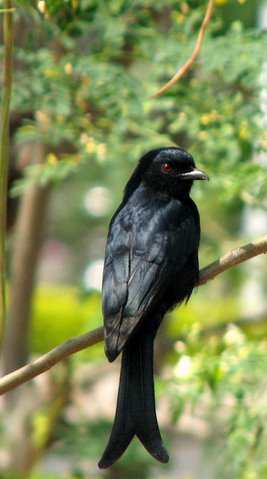 </lj-cut>
And here's a bird which I couldn't identify until our guide took a look at my photograph.
It's the BARE-FACED GO-AWAY BIRD that I talked about in my earlier post...
</lj-cut>
And here's a bird which I couldn't identify until our guide took a look at my photograph.
It's the BARE-FACED GO-AWAY BIRD that I talked about in my earlier post...
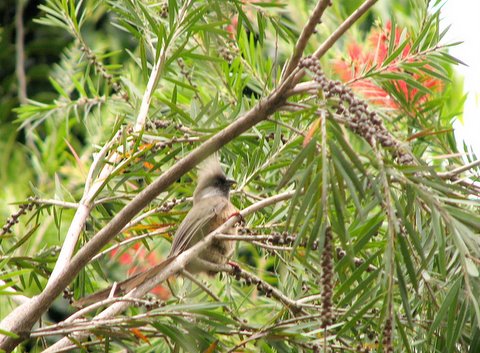 What a fantastic name! The bird makes a kind of "gweyyy" sound, that white travellers interpreted as "Go Away"....and why call it bare-faced when it has such a nice crest, I really don't know!
After he realized that we were both seriously interested in everything-- birds, mammals, insects, trees, the lot-- he lent us three excellent reference books on the three regions that we visited. One was the Audubon book on East Africa, and the others were books on the Ngorongoro Conservation Area, the Serengeti, and the Lake Manyara area, with special reference to the tree-climbing lions...
Oh yes, they will be posted too, soon, soon...but right now, the bare-faced go-away bird is telling me to go away from the computer and get on with the task of cooking dinner for our guests tonight (I had, indeed, forgotten that this is the season for all NRI's...Non Resident Indians, friends and relatives alike, to come visiting...a cousin from New York and a close friend from St Louis are here with their families right now.)
To whet your appetite....two Thomson's Gazelles fighting, a pride of lions (three lionesses, two adorably roly-poly cubs, and two lions) walking unconcernedly past our safari jeep, two tree-climbing lions of Manyara, ungulates by the hundreds, two ostriches doing a mating dance with an audience of two cheetahs (in the far distance, alas), a cheetah, also somewhat far away, feasting on a gazelle, a golden jackal with its cub....plus homely touches like a shrike feeding its hungry baby, Yes, I do love watching mothers and their children, no matter what the species they belong to!
What a fantastic name! The bird makes a kind of "gweyyy" sound, that white travellers interpreted as "Go Away"....and why call it bare-faced when it has such a nice crest, I really don't know!
After he realized that we were both seriously interested in everything-- birds, mammals, insects, trees, the lot-- he lent us three excellent reference books on the three regions that we visited. One was the Audubon book on East Africa, and the others were books on the Ngorongoro Conservation Area, the Serengeti, and the Lake Manyara area, with special reference to the tree-climbing lions...
Oh yes, they will be posted too, soon, soon...but right now, the bare-faced go-away bird is telling me to go away from the computer and get on with the task of cooking dinner for our guests tonight (I had, indeed, forgotten that this is the season for all NRI's...Non Resident Indians, friends and relatives alike, to come visiting...a cousin from New York and a close friend from St Louis are here with their families right now.)
To whet your appetite....two Thomson's Gazelles fighting, a pride of lions (three lionesses, two adorably roly-poly cubs, and two lions) walking unconcernedly past our safari jeep, two tree-climbing lions of Manyara, ungulates by the hundreds, two ostriches doing a mating dance with an audience of two cheetahs (in the far distance, alas), a cheetah, also somewhat far away, feasting on a gazelle, a golden jackal with its cub....plus homely touches like a shrike feeding its hungry baby, Yes, I do love watching mothers and their children, no matter what the species they belong to!

